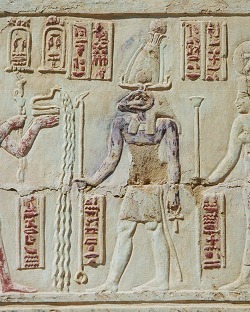
Ram-headed god with temples in several places in Egypt, the most important being those in Elephantine and Esna. In Elephantine he formed a triad with Satet and Anuqet. The Egyptians believed that the waters of the Nile came out of Nun from a hole in the earth at Elephantine. The inundation waters also entered Egypt here, bringing fertile mud with them. Khnum was regarded as the lord of the cataract area or as the protector of the source of the Nile. Probably because of his relationship with the life-giving water and the mud, Khnum also appeared as a potter, who formed man and his 'ka' on his wheel. But we also hear of him making the child in the womb of its mother and, together with the goddess Heqet, assisting at the birth. The fact that the Egyptians attributed great potency to the ram undoubtedly played a role. All this turned the god into a creator god, who according to some texts also created the gods. Khnum is sometimes referred to as the 'ba' (an aspect of man and god, the physical manifestation) of Re, perhaps because the Egyptian word for ram is 'ba'. Depictions of the sun god during his nocturnal journey through the underworld show him with the head of a ram. Khnum himself was depicted either as a ram or as a man with a ram's head. The horizontally twisted horns show that we are dealing with a ram of the species 'ovis longipes palaeoaegyptiacus'. This was the earliest type to be domesticated in Egypt, but became extinct sometime in the New Kingdom. Nevertheless, the shape of the horns was preserved even in later depictions of Khnum. This makes the god easy to differentiate in depictions from other ram-headed gods, such as Amun whose horns curl.